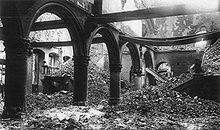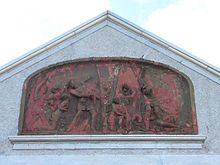Rape of Belgium - Picture
More about World War 1

|
|
Rape of Belgium

Picture - The ruins of the library of the Catholic University of Leuven after it was burned in 1914.
The Rape of Belgium (4 August through September 1914) is a term describing a series of German war crimes in the opening months of the World War I.
The neutrality of Belgium had been guaranteed by the Treaty of London (1839) which had been signed by Prussia. The Treaty of London was confirmed in 1871 and at the Hague Conference in 1907 by the German Empire, which largely inherited and reaffirmed Prussia's diplomatic obligations. However the German Schlieffen Plan required that German military violate Belgium's neutrality in order to outflank the French Army, concentrated in eastern France. The German Chancellor Theobald von Bethmann Hollweg dismissed the treaty of 1839 as a "scrap of paper".
Throughout the beginning of the war German army engaged in numerous atrocities against civilian population in Belgium, and destruction of civilian property.
German atrocities in Belgium
German troops, afraid of Belgian guerrilla fighters, or francs-tireurs, burned homes and executed civilians throughout eastern and central Belgium, including Aarschot (156 dead), Andenne (211 dead), Tamines (383 dead) and Dinant (674 dead). The victims included women and children.
On August 25, 1914 the German army ravaged the city of Leuven, deliberately burning the University's library of 300,000 medieval books and manuscripts with gasoline, killing 248 residents and expelling the entire population of 10,000. Civilian homes were set on fire and citizens often shot on the place they stood. Over 2,000 buildings were destroyed and large amounts of strategic materials, foodstuffs and modern industrial equipment were looted and transferred to Germany. These actions brought worldwide condemnation.
![World War 1 Picture - World War I, U.S propaganda poster.[8]](./images/1-images52211/220px-Remember_Belgium.jpg)
Picture - World War I, U.S propaganda poster.[8]
Exploitation of German atrocities in propaganda
The invasion of Belgium was cited by the United Kingdom as a reason for entering the war as a member of the Triple Entente. The report of German war crimes galvanized support for the British government's decision. They also sparked much wartime propaganda-in sensationalist war posters in Britain, such as created by Louis Raemaekers, the Germans were drawn as Huns or gorillas, dehumanized and immoral.
The British government regularly fabricated bizarre stories of the "rape" of Belgium and supplied them to the public, such as Belgian nuns being tied to the clappers of church bells and squelched to death when the bells were rung. In his book Roosevelt and Hitler, author Robert E. Herzstein states, "The Germans could not seem to find a way to counteract powerful British propaganda about the 'Rape of Belgium' and other alleged atrocities. Reports paved the way for other propaganda of the war such as The Crucified Soldier, The Angels of Mons, and the German corpse factory, Kadaververwertungsanstalt.
Interviews
In an attempt to substantiate the rumors, official commissions were established in Belgium and Britain. Thousands of witnesses were interviewed. While the conclusions of the British government in The Bryce Report were correct, the Appendix included some dubious testimony, particularly from Belgian soldiers. Testimony in the reports of the Belgian commission, particularly in the two volumes on war crimes issued after the war, is more accurate.
Terrorize
In some places, particularly Lix¨ge, Andenne, and Leuven, but firstly Dinant, there is evidence that the violence against civilians was premeditated. But in Dinant the German army believed sincerely the inhabitants of Dinant were as dangerous enemies as the French soldiers themselves.
Adolf Hitler stated that:
Horne and Kramer's explanation
In-depth historical studies on this subject include German Atrocities 1914: A History of Denial by John Horne and Alan Kramer, The Rape of Belgium: The Untold Story of World War 1 by Larry Zuckerman, and Rehearsals: The German Army in Belgium, August 1914 by Jeff Lipkes.
Horne and Kramer give many explanations of these crimes and firstly (but not only), the collective fear of the People's War:
The source of the collective fantasy of the People's War and of the harsh reprisals with which the German army (up to its highest level) responded are to be found in the memory of the Franco-Prussian War of 1870-1, when the German armies indeed faced irregular Republican soldiers (or francs-tireurs), and in the way in which the spectre of civilian involvement in warfare conjured up the worst fears of democratic and revolutionary disorder for a conservative officer corps.
inexperience leading to lack of discipline amongst German soldiers, drunkenness; "friendly fire" incidents arising from panic; frequent collisions with Belgian and French rearguards leading to confusion; rage at the stubborn and at first successful defence of Lix¨ge during the Battle of Lix¨ge, when German's invasion firstly failed; rage at Belgian resistance at all, not seen as a people entitled to defend themselves; prevailing almost hatred of the Roman Catholic clergy in Belgium and France; ambiguous or inadequate German field service regulations regarding civilians; failure of German logistics later leading to uncontrolled looting etc.
High clerk of German ministry in Dinant
On 6 May 2001, in Dinant, Walter Kolbow, a high secretary at the German ministry of defence, bowed before a monument to the victims, placing a wreath at the foot of the stone which bore this inscription: To the 674 Dinantais martyrs, innocent victims of German barbarism.
War crimes

Picture - A bizarre relic of the Great War, tucked away in a backstreet in Bonnington, Edinburgh
Even today, the war crimes of August 1914 are often dismissed as British propaganda. Scholars in the U.S. and U.K. began taking them seriously in the mid-1990s. There is an ongoing debate between those who believe the German army acted primarily out of paranoia and those who emphasize additional causes (Lipkes). Zuckerman documents the continuing oppression of Belgians under German occupation, arguing that this was the real "Rape of Belgium".
Author Simon Winder notes that the German army was undoubtedly brutal in Belgium, but only to a degree the British were well acquainted with from their own behavior, such as in China or South Africa.
More aircraft.
Source: WikiPedia